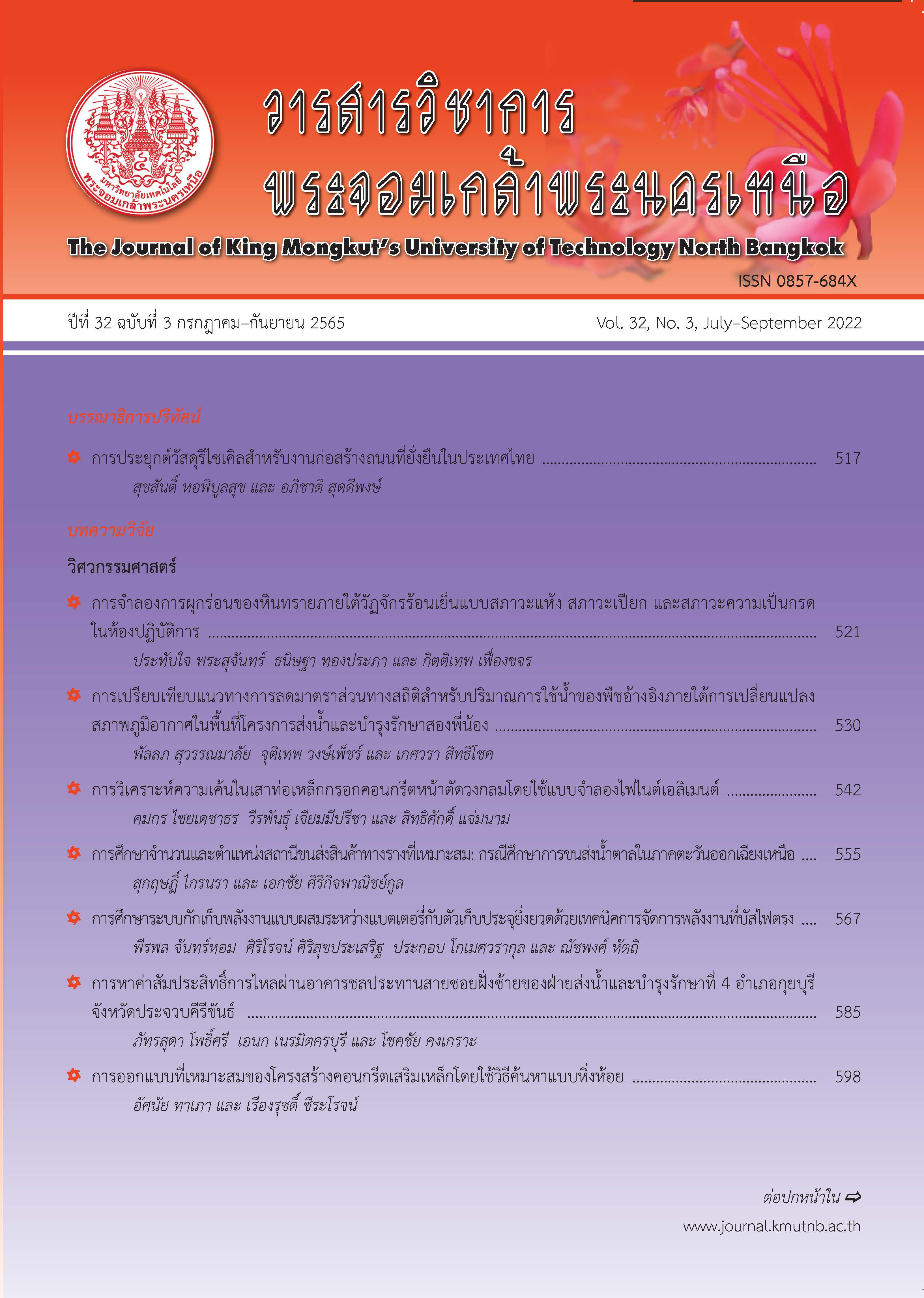ปัจจัยที่เหมาะสมระหว่างอุณหภูมิและเวลาการอบเพิ่มคาร์บอนในการชุบแข็งมีดโต้ด้วยกระบวนการแพ็กคาร์เบอไรซิงโดยใช้เปลือกหอยขมเป็นสารเร่งปฏิกิริยา
Main Article Content
บทคัดย่อ
งานวิจัยนี้มีวัตถุประสงค์เพื่อศึกษาปัจจัยที่เหมาะสมของอุณหภูมิและเวลาการอบเพิ่มคาร์บอนที่มีผลต่อสมบัติเชิงกลของมีดโต้ที่ชุบแข็งด้วยกระบวนการแพ็กคาร์เบอไรซิงโดยใช้เปลือกหอยขมเป็นสารเร่งปฏิกิริยา สมบัติเชิงกลของมีดโต้ประกอบด้วยค่าความแข็งและความต้านทานแรงกระแทก สมบัติเชิงกลที่ได้จากการทดลองจะนำมาทำการเปรียบเทียบกับค่าที่ได้จากมีดโต้ที่ตีขึ้นรูปและชุบแข็งจากชุมชนตีมีด โดยมีค่าความแข็งเฉลี่ย 607.0 HV ค่าความต้านทานแรงกระแทกเฉลี่ย 14.0 Joules การทดลองชุบแข็งมีดโต้ด้วยกระบวนการแพ็กคาร์เบอไรซิงใช้เหล็กกล้าคาร์บอนต่ำตีขึ้นรูปให้มีขนาดและรูปทรงเช่นเดียวกับมีดโต้ของชุมชน สารเพิ่มคาร์บอนประกอบด้วยผงถ่านไม้ยูคาลิปตัสสัดส่วน 80% ผสมกับผงเปลือกหอยขมสัดส่วน 20% โดยน้ำหนัก การทดลองอบชุบทางความร้อนใช้หลักการออกแบบการทดลอง (DOE) และวิเคราะห์ปัจจัยที่เหมาะสมตามหลักการทางสถิติ ปัจจัยในการศึกษาแบ่งออกเป็น 2 ปัจจัย โดยปัจจัยแรก คือ อุณหภูมิอบเพิ่มคาร์บอนมีอยู่ 3 ระดับ ได้แก่ 960, 980 และ 1,000 องศาเซลเซียส ปัจจัยที่สอง คือ เวลาอบเพิ่มคาร์บอนมีอยู่ 3 ระดับ ได้แก่ 60, 90 และ 120 นาที การทดลองอบเพิ่มคาร์บอนทำตามระดับปัจจัยที่กำหนด จากนั้นนำชิ้นทดสอบไปทำการชุบแข็งด้วยอุณหภูมิออสเทไนต์ 780 องศาเซลเซียส ใช้เวลาอบแช่ 15 นาทีจุ่มชุบในน้ำ แล้วนำไปทำเทมเพอร์ที่อุณหภูมิ 180 องศาเซลเซียส เป็นเวลา 60 นาที ผลจากการวิเคราะห์ พบว่า ปัจจัยที่เหมาะสมของอุณหภูมิอบเพิ่มคาร์บอน คือ 1,000 องศาเซลเซียส เวลาในการอบเพิ่มคาร์บอน คือ 96.1 นาที โดยได้ค่าความแข็งเฉลี่ย 606.9 HV และค่าความต้านทานแรงกระแทกเฉลี่ย 24.8 Joules ผลของการชุบแข็งเพื่อยืนยันผลโดยใช้อุณหภูมิและเวลาอบเพิ่มคาร์บอนที่ได้จากการวิเคราะห์ปัจจัยที่เหมาะสม ได้ค่าความแข็งเฉลี่ย 610.2 HV และค่าความต้านทานแรงกระแทกเฉลี่ย 21.6 Joules ซึ่งเป็นค่าที่อยู่ในขอบเขตของสมบัติเชิงกลของมีดที่ตีและชุบแข็งจากชุมชนตีมีด
Article Details

อนุญาตภายใต้เงื่อนไข Creative Commons Attribution-NonCommercial-NoDerivatives 4.0 International License.
บทความที่ลงตีพิมพ์เป็นข้อคิดเห็นของผู้เขียนเท่านั้น
ผู้เขียนจะต้องเป็นผู้รับผิดชอบต่อผลทางกฎหมายใดๆ ที่อาจเกิดขึ้นจากบทความนั้น
เอกสารอ้างอิง
M. Sathirajinda, Iron & Steel Heat Treatment Engineering. Bangkok : The Engineering Institute of Thailand under His Majesty the King’s Patronage, 1995 (in Thai).
P. Pitsuwan, P. Suwan, Y. Sengty, and P. Kongsong, “Influence of catalyst on surface hardening of low carbon steel by pack carburizing with mangrove charcoal powder,” Journal of Industral Technology Ubon Ratchathani Rajabhat University, vol. 8, no. 2, pp.1–12, 2018 (in Thai).
M. R. Oyawoye, O. R. Momoh, and Y. M. Sani, “Kinetic studies of thermal decomposition of periwinkle shell,” Nigerian Research Journals of Engineering and Environmental Sciences, vol. 4, no. 2, pp. 702–708, 2019.
B. H. Setiamarga and U. Rumendi. “Comparison of the effectiveness of pack carburization energizers for surface hardening of low carbon steel,” in Proceedings The 2nd AUN/SEED-Net Regional Conference on Materials Engineering: Material for Changing World. Burapha University, Thailand, 2009, pp. 107–110.
D C. Montgomery, Design and Analysis of Experiments. John Wiley & Sons Inc, 2009.
S. Srinork, N. Thammachot, J. Nithikarnjanatharn, R. Duekunthod, S. Noyming, C. Peeratatsuwan, and A. Mayai, “The optimization parameters in pack carburizing process by using lime stone powder as energizer for hardening the sugarcane cutting knife,” in Proceedings Industrial Engineering Network Conference Local Industrial Innovations for Global Community, 2016, pp. 1205–1210 (in Thai) .
S. Srisuk, N. Thammachot, J. Banthao, J. Nithikarnjanatharn, W. Homjabok, A. Mayai, and S. Noyming, “A study of the relation of temperature and time effected on the big knives hardening in pack carburizing process by using calcium carbonate,” in Proceedings Operations Research, 2019, pp. 202–207 (in Thai).
D. R. Askeland and P. P. Phule, The Science and Engineering of Materials. Brooks/Cole, Thomson Learning, Inc, 2003.
H. S. Avner, Introduction to Physical Metallurgy, 2nd ed. Singapore: McGrall-Hill, Inc., 1974.
W. F. Smith, Principle of Materials Science and Engineering, 3rd ed. McGrall-Hill, Inc. 1996.
W. Homjabok, N. Thammachot and N. Thadee, “The comparison of catalyst between the egg shell and CaCO3 in the pack carburizing process,” Research Journals Eastern Rajamangala University of Technology, vol. 8, no. 1, pp. 29–36, 2015 (in Thai).

